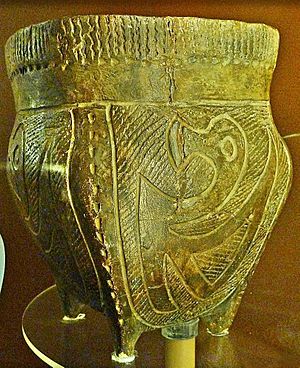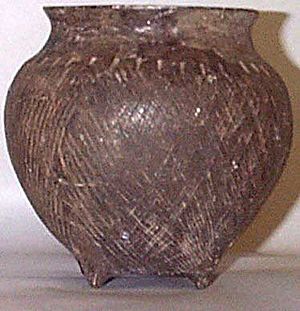Hopewell pottery facts for kids

Hopewell pottery refers to the special clay pots made by different groups of people during the Hopewell tradition. This tradition lasted from about 200 BCE to 400 CE. These ancient pots are found as artifacts (old objects) at dig sites in the central and southeastern parts of America. The Hopewell people lived near the Mississippi River and Illinois River during a time called the Middle Woodland Period. Their influence, known as the Hopewell Interaction Sphere, reached from the Gulf of Mexico all the way up to Ontario, Canada.
Contents
What Hopewell Pottery Was Used For
Hopewell pottery had many uses in daily life. People used these pots for storing food and for cooking meals. Some pots were also very special. They were used to hold offerings during important burial ceremonies. The pots made for ceremonies were often more delicate and fancy. They looked different from the pots used every day.
How Hopewell Pottery Was Made
People in the Hopewell culture used a method called the coiled method. First, they would roll clay into long ropes or coils. Then, they would stack these coils on top of each other. They would smooth the coils together to form the shape of a pot.
Shaping and Smoothing the Clay
After making the basic shape, they used tools to finish the pot. They would use a paddle and an anvil. The paddle was a flat tool to tap the outside of the pot. The anvil was a stone held inside the pot. This helped to shape the pot and make its walls smooth and even.
Decorating and Firing Hopewell Pots
The last steps were decorating and firing the pottery. Before baking, artists often carved designs into the clay. They might also press stamps into the wet clay. Sometimes, they used a technique called zone-stamping. This meant they would mark off different "zones" on the pot. They would then stamp designs inside these zones. The areas around the stamped zones were left smooth. This created a cool contrast.
Hopewell pottery is known for certain designs. These include patterns that look like crosshatching (crisscross lines). They also made pots with special bands and rims. Many pots also featured very detailed bird designs.
See also
- Ceramics of indigenous peoples of the Americas
- Fort Ancient culture pottery
- Mississippian culture pottery
- Plaquemine culture pottery
- Visual arts by indigenous peoples of the Americas


